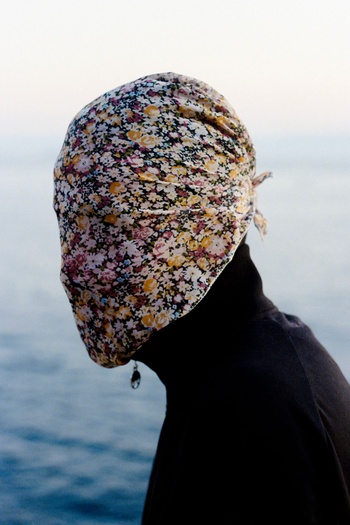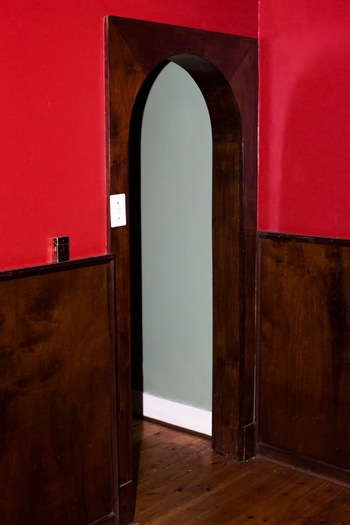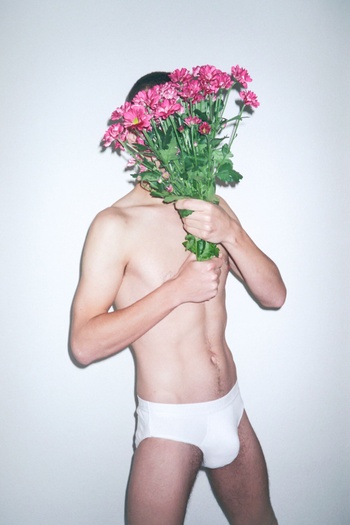Ugo Woatzi, an emerging talent in contemporary photography, presents his first solo exhibition at the gallery that's what x said. In his series 'Chameleon', he explores the queer community's methods of camouflage and celebrates their beauty. So that acceptance and the dream may triumph.
© Ugo Woatzi

© Ugo Woatzi
| Mask 2019
For Ugo Woatzi (30), the discovery of photography has been a lengthy process, the roots of which lie in childhood and the impossibility of being oneself. “I grew up in the south-west of France in a little village an hour and a half from Toulouse. In an environment in which I had to do everything that was expected of a man: play rugby, chop wood, and fix things. It was always hugely restrictive and constraining and that's why I now need to show that there are a thousand possible ways to be masculine.”
Having moved to Brussels to finish a master's he wasn't very enthusiastic about, in political science at ULB, Ugo Woatzi seems to have found his way in the city at the same time as discovering his own path in life. “It was in Brussels that I began to accept that I was a queer person. It was there that I began to explore the world at night, which is a space of incredible liberation.”
Determined to follow his heart, the young man set sail for Johannesburg to study photography for a year at the Market Photo Workshop, a school founded by the South African photographer David Goldblatt, before returning to Brussels to complete his training at the LUCA School of Arts. “I have always loved photography, but it took me some time to convince myself that it was possible.”
In South Africa, Ugo Woatzi mostly studied African photography. This artistic initiation would have the effect of decentring his gaze and enabling him to envision the practice beyond the sacrosanct codes of Western photography. “It did me a lot of good and I think there are many elements in my photos that lie outside of the European aesthetic.”

© Ugo Woatzi
| Escape 2019
A few years later, while in residence on Réunion, the photographer would continue to explore other realities. “I had to find my place as a white man in a land that was a former colony. It was a constant process of learning about positioning, repositioning, and discovery. It enriched my work and my life enormously.”
Out of Europe
Among his main sources of inspiration, Ugo Woatzi includes Zanele Muholi's iconic black-and-white portraits of South-African black lesbian women, the work (featuring many self-portraits) of the well-known contemporary African photographer Samuel Fosso, the free and unique nudes of the gay Chinese photographer Ren Hang, who was taken too soon, and the surrealism of the intensely bright and colourful portraits of the Dutch photographer Viviane Sassen. “They are photographers who do a huge amount of work with bodies, composition, and colours. They employ visual metaphors that are extremely powerful.”
“It was when I discovered photography that I began to accept myself.” During his training in Johannesburg, Ugo Woatzi gravitated instinctively towards self-portrait, a way of exploring his gender and his identity, of experimenting with his body and staging it. “I was alone with my camera; I wasn't bothering anyone. Suddenly, everything became possible.”
In doing so, the photographer laid the foundations for his aesthetic, a trademark poetic style in which the notion of performance is combined with the intensity of the flash lighting and of the symbolic resources that nature provides. “That period constituted a form of personal therapy that then enabled me to turn my attention to the people in my community and people like me and to carry out this photography project with them. And, when I create an image with a person, we take care of one another.”
So began the series entitled 'Chameleon', made up of portraits of people he knew and of still lifes. The work was developed through a collaborative process that involved exchanges and discussions with the subjects who agreed to present themselves in front of Ugo Woatzi's camera. For his part, he always ensures that he has their consent. “For example, some people don't want their faces to be shown. Such protective measures are a reality for the queer community, and I want to show that in my work.”

© Ugo Woatzi
| Bloom 2020
In the intimate atmosphere that pervades his images (“it's just me and the model”), the photographer invites his subject to join the performance, the game of fiction and self-exploration. “I think that notion of performance goes back to childhood. When I was a child, I very quickly realised that I could not show who I was because I would immediately get called a faggot. To survive at school, I had to perform and be someone else. Today, when I go out in public, I still sometimes have to play the part of the virile and hetero man.” The title of the series, 'Chameleon', relates back to that idea of permanent adaptation. “In some spaces it is possible for us to be ourselves, in others it is not. My photos taken at night reflect that duality of fear and excitement, danger and experimentation. For the queer community, the world at night is the ultimate space of self-expression.”
A kinder society
The bodies are mixed with an interplay of textures, colours, objects, and materials, in which a bouquet of flowers often appears, poetic and fragile. In the same way, the relatively cramped compositions of Ugo Woatzi's flash photographs leave little of the surrounding space visible. Just enough to let the viewer's imagination run wild. “I try to disregard space in order to create a dreamlike utopia that can be understood as a space of acceptance and hope for a queer community that faces a lot of cruelty and violence. I tackle difficult subjects using an aesthetic that enables me to disconnect from an exhausting reality and to dream. The fiction provides a kind of healing.”
In the construction of this earthly utopia, the vegetation, seascapes, and streams add to that sense of escape. “I was born in the countryside, and I lived there until I was 18. I have always seen nature as a sort of escape. School and my social environment were not comfortable spaces and nature represented a space of calm and freedom. I also see natural spaces as fluid spaces. In my work, I try to make the link between the fluidity of bodies, of our identities, and of masculinities, and the fluidity of nature.”
Having presented 'Chameleon' as part of group exhibitions in spaces such as Contretype in Brussels and at the FOMU in Antwerp, Ugo Woatzi has been given his first solo exhibition at the recently opened gallery in the Marollen/Marolles district that's what x said. “Each time, I try to present a different staging that is adapted to the space.”
In parallel with the exhibition, the photographer will work alongside the drag queen Athena Sorgelikis to lead a cycle of workshops with six teenagers in their final year at secondary school. The objective is to “queer” their class photo. “The individual portrait of the class photo is extremely coded. The goal is to help them to create their own utopian portrait, to try out makeup and experiment with their clothes if they want to. In other words, to dream. I think it is good to act as early as possible, so that society becomes kinder.”
UGO WOATZI: CHAMELEON
14/1 > 13/2, that’s what x said
Read more about: Expo